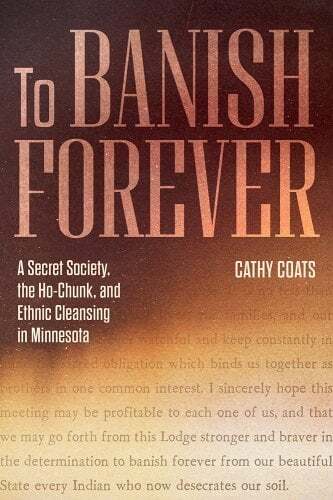Double Book Feature: To Banish Forever by Cathy Coats and The Lost Wife by Susanna Moore
I recently discovered two books—one fiction and one nonfiction—that really interest me. Although I haven’t had time to read them yet, I wanted to share them with you in case you’re interested too.
The fiction novel, The Lost Wife by Susanna Moore, tells the story of Sarah Wakefield. She was taken captive by the Dakota during the U.S.-Dakota War but was protected by Chaska. By the end of her captivity, Sarah sympathized with Chaska and the Dakota. I found this novel on the blog Herstory Revisited, created by author N.J. Mastro.
The nonfiction book is called To Banish Forever by Cathy Coats. It explores the troubling history of The Knights of the Forest, an organization founded in Mankato in 1863. Their goal was to remove all tribes of Indians from the State of Minnesota. I learned about this book from fellow Minnesota author Edward Sheehy.
Both titles are important historical reads that I hope to dive into soon.
The Lost Wife by Susanna Moore
Drawn partly from a true story, a searing, totally immersive novel about a devastating Native American revolt, and a woman caught in the middle of the conflict.
In the summer of 1855, Sarah Brinton abandons her husband and child to make the long and difficult journey to Minnesota, where she will meet a childhood friend. Arriving at a small frontier post on the edge of the prairie, she discovers that her friend has died of cholera. Without work or money or friends, she quickly finds a husband who will become the resident physician at an Indian agency on the Yellow Medicine River. As one of the earliest settlers in the area, Sarah anticipates unease and hardship, but instead finds acceptance and kinship with the Sioux women who live on the nearby reservation. She learns to speak their language, nourishing a companionship with them which far exceeds that which she shares with her strange and distant husband.
An endless flow of White settlers are clearing the forests and claiming land. The government has yet to pay the Sioux the annuities awarded them each July for the sale of the land, and starvation and disease begin to decimate the Sioux community. What inevitably and tragically follows is the Sioux Uprising of 1862. While seeking safety at a nearby fort, Sarah and her two young children are abducted by Sioux warriors. They are unexpectedly kept safe by one of the men, who protects them until their rescue six weeks later by federal troops. Because of her sympathy for the Sioux, Sarah has become an outcast, falsely accused of marriage with her Native American captor. Vilified by the whites and despised by her husband, she is lost to both worlds.
Intimate, raw, compelling, and brilliantly subversive, Susanna Moore explores the history of Native American suffering and the rapacious settlement of the Western frontier.

About the Author
Susanna Moore is a writer and teacher based in New York City.
She is the author of a dozen books, including In the Cut, The Whiteness of Bones, and My Old Sweetheart. Her memoir Miss Aluminum was published in 2020.
Susanna’s latest novel, The Lost Wife, is about a seminal and shameful moment in America’s conquest of the West. Drawing partly from a true story, it brings to life a devastating Native American revolt and the woman caught in the middle of the conflict.
To Banish Forever by Cathy Coats
The largely untold story of the Ho-Chunk exile from Minnesota, in which local white residents sought to expel all indigenous people from the region and deny Native claims to some of the richest farmland in the world.
In 1863, after the end of the US-Dakota War, a group of men in Mankato, Minnesota, formed a secret society. At the beginning of every meeting, members of the Knights of the Forest recited its ritual pledge, including these words: “I sincerely hope this meeting may be profitable to each one of us, and that we may go forth from this Lodge stronger and braver in the determination to banish forever from our beautiful State every Indian who now desecrates our soil.”
The Ho-Chunk people, who had not participated in the war, occupied a reservation about two miles south of Mankato on some of the state’s richest agricultural lands. The Knights–determined to claim these lands for their own profit–advocated for the removal of the Ho-Chunk, who had already been forced to move three times before settling in Blue Earth County of south-central Minnesota. Exploiting the fears of white people living in the area at the end of the brutal war, the Knights sent armed men to surround the Ho-Chunk reservation, threatening to shoot anyone who crossed the line. Within just a few years, the Ho-Chunk had been kicked off their land and removed to reservations outside of the state.
This is the story of the Knights, the Ho-Chunk, and the ethnic cleansing of southern Minnesota.

About the Author
Cathy Coats is the metadata specialist at the University of Minnesota Libraries. She previously worked at the James W. Miller Learning Resources Center at St. Cloud State University. She lives in St. Cloud, Minnesota.



